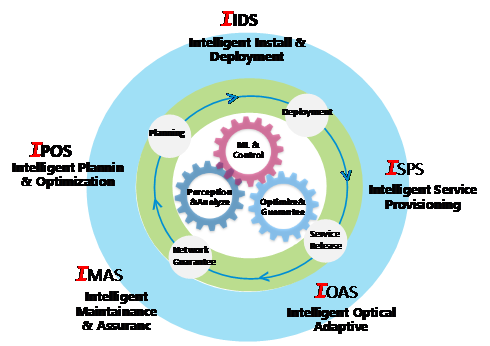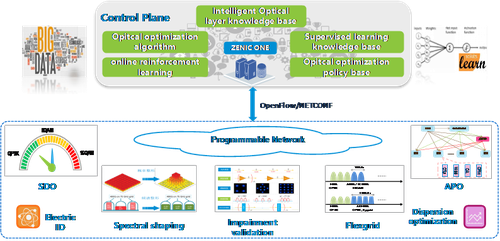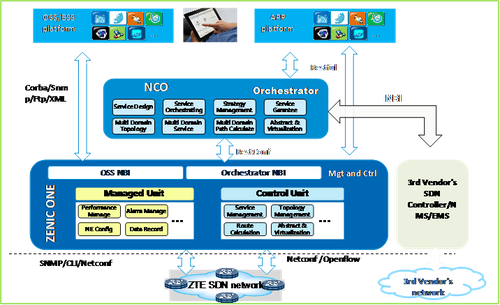Intelligent Control, Simplified Management – ZTE Intelligent OTN Solution
May 22, 2019

By Lu Gang & Wei Dengpan, ZTE Corporation
Industrial trend of intelligentization
With the advent of 5G mobile Internet era, transport network operation is facing greater challenges and pressure in cost reduction, resource utilization improvement and fast service provisioning. Intelligentization is an inevitable stage when the traditional optical network develops to the programmable optical network. With the development of OTN, there will be more and more multi-granularity, large-bandwidth, flexible and complicated scheduling requirements; network deployment and maintenance as well as service configuration and management will become more and more difficult; network control will gradually evolve from distributed control to SDN-based centralized control.
With improved efficiency and simplified O&M (Operation and Maintenance), the centralized network has increasingly higher requirements for intelligentization, needing a more intelligent, flexible and convenient OTN solution for management. ZTE’s intelligent OTN solution employs the Cloud Native architecture with the widest coverage to provide a full series of microservice-based intelligent O&M applications. At the same time, it provides a definable knowledge base to complete machine training, which is widely used in AI to improve intelligentization performance of the network.
ZTE intelligent OTN solution
ZTE’s intelligent OTN solution Athena (OTN) is composed of intelligent installation and deployment, intelligent service provisioning, intelligent optical layer self-adaptation, intelligent O&M and warranty and intelligent planning & optimization. Being customer-oriented and service-oriented, the solution covers network planning, network deployment, service provisioning, network and service protection and optimization, and forms a 5i closed-loop system with positive feedback. With the aid of AI, machine learning can make progress continuously and intelligent control can be enhanced by iteration.

1. Intelligent planning and optimization
Service planning and optimization directly influences capex and opex of the entire network. Employing an inspiring algorithm, ZTE’s intelligent planning and optimization solution implements multi-objective planning, transmission capability evaluation, fault simulation analysis and defragmentation, and achieves the optimal balance between OSNR, total number of trunks, and wave channel utilization. Besides, it continues to optimize the algorithm through machine learning to implement the best service planning and improve the efficiency of planning and optimization.
2. Intelligent installation and deployment
With growing network bandwidth, the number of subracks is increasing, and network devices and networking are becoming more and more complicated. There will be tens of thousands of optical interfaces and optical fibers. The workload is heavy to manually connect fibers and install devices during installation and correctly synchronize the information to the management and control platform. The intelligent installation and deployment solution can solve the above problem through automatic discovery of NE topology, automatic discovery and report of resources, automatic installation and creation of NEs and incorrect fiber connection check, which can make installation and deployment work simple and fast.
3. Intelligent service provisioning
The intelligent management and control plane can select the service path, wave channel and subchannel and use the appropriate coding mode, wavelength spacing and spectral form to implement fully automatic service provisioning based on manual rules and machine learning algorithms while taking intelligently planned data and actual network status into consideration. It can also provide RWA/RSA, BoD, PoD and virtual network slicing as required.
4. Intelligent optical layer self-adaptation
Optical layer self-adaptation mainly includes SDO (Software Defined Optics) online planning and automatic optical power adjustment based on manual policies and intelligent algorithms. SDO includes intelligent adjustment in service group type, signal modulation format, signal spectrum shape and modulation and receiving of signals transmitted by the optical module. Automatic optical power adjustment can solve the problem of power parameter changes caused by environment, manual operation, and natural aging of fibers and components during network operation. The intelligent control of self-adaptation can keep the most appropriate power, spectrum and OSNR parameters to maximally reduce the effect of network changes on services.
5. Intelligent maintenance and adjustment
To simplify O&M, intelligent maintenance and adjustment mainly implements performance prediction, fault prediction, fault correlation analysis and preventive maintenance evaluation. Performance prediction and analysis includes OSNR prediction, price and margin estimation, process analysis and linear prediction. It is gradually iterated based on machine learning algorithms to improve the correctness of prediction.
Intelligent OTN optical layer self-adaptation
ZTE’s intelligent OTN solution provides complete self-adaptation at the optical layer. With comprehensive optical layer self-adaptation system including cases of SDO, optical performance prediction and optical impairment compensation. It monitor line optical power, OSNR and spectrum in real time. Using optical layer tuning algorithms and policies, it provides an intelligent optical layer knowledge base, a monitoring learning knowledge base and AI online enhanced learning capability to respond to customers’ requirements and network changes quickly, efficiently and correctly.

Intelligent OTN optical layer self-adaptation can be invoked by other systems and functions as a function module.
Optical layer self-adaptation can be enabled in service provisioning. When an optical layer service is created, optical power optimization can improve the service performance without changing the modulation format/rate to resist bigger network performance changes. For the existing network services, optical power optimization can optimize optical layer services without changing the service paths or interrupting the services.
For long-haul route restoration of optical layer services, SDO can dynamically adjust the Constellation density of the signals, to transport the services over a longer distance, thus improving the spectrum utilization in the network and providing more possibilities in path selection. The hybrid modulation technology is used to perform flexible adjustment to meet the transport performance requirements for the optical transmission distance. On-demand modulation is implemented to highly improve the network intelligentization level, maximize the transport capability and improve the service restoration capability.
All E-OTN series products of ZTE including the ZXONE 9700 and the ZXMP M721 can flexibly invoke the intelligent optical layer self-adaptation, together with the features of the devices themselves, to provide enhanced, elastic, end-to-end intelligent solutions for users.
Features of ZENIC ONE (OTN) product
The ZENIC ONE (OTN) is the practical management and control product of Athena (OTN), ZTE’s overall intelligent transport solution. It has powerful management and control layer functions and provide open, elastic, efficient and intelligent network solutions. It can implement fast automatic service provisioning, automatic service restoration upon multi-point failure and hierarchical SLA user service to simplify O&M and improve O&M efficiency.
ZENIC ONE(OTN) Product Architecture

1. Open
The ZENIC ONE (OTN) is interconnected with third-party orchestrator/BSS/OSS through northbound interfaces. It virtualizes network capabilities to Application Program Interfaces (APIs) and provides them to the application layer, to implement fast automatic translation and adaptation of user intents, service models, network models and device models, thus building open and programmable intent-driven network scenarios.
2. Intelligent
One-key service provisioning: Through centralized intelligent control, it performs fast and convenient service provisioning in complicated network scenarios. It supports fast provisioning and management of E2E L0/L1/L2 services to accelerate private line service deployment.
SLA differentiated service: It provides multiple protection restoration levels for different customers. It forms an end-to-end self-service O&M closed loop through data collection, analysis, policing and control, to implement intelligent self-healing from network faults and hierarchical services.
3. Elastic
Fully componentized design and decoupling enable elastic expansion of functions. The system performs dynamic loading/unloading with function modules as the unit. The loosely coupled architecture makes component maintenance independent.
The system implements automatic traffic optimization and dynamic bandwidth adjustment on demand, which cannot be perceived by users nor affect the services.
The physical network is sliced into multiple virtual subnets and leased to different customers, so that the customers can perform self-service and share the resources.
The system can resist multi-point failure. It can make full use of network resources to provide rerouting for services, so as to guarantee service connectivity.
Conclusion and prospects
Focusing on the requirements and challenges of mobile Internet and broadband development, ZTE launched the new-generation intelligent OTN solutions and products. Employing the intelligent planning, management and control system, organically integrating 100G/beyond 100G, Flexgrid, packet, SDO, OXC and PIC, it suits all application scenarios including 5G mobile transport, MAN unified transport, enterprise private line networks and IDC.(Internet Data Center) interconnect. ZTE provides intelligent solutions covering the whole process from network planning and deployment to service provisioning and warranty, with an aim to better serve the customers and services, further improve user experience and help customers cut opex and explore new profit models.
ZTE’s intelligent OTN solution will build simple, efficient, flexible and open optical transport networks for customers with the help of AI.
Read more about:
Vendor SpotlightsYou May Also Like










_1.jpg?width=300&auto=webp&quality=80&disable=upscale)
